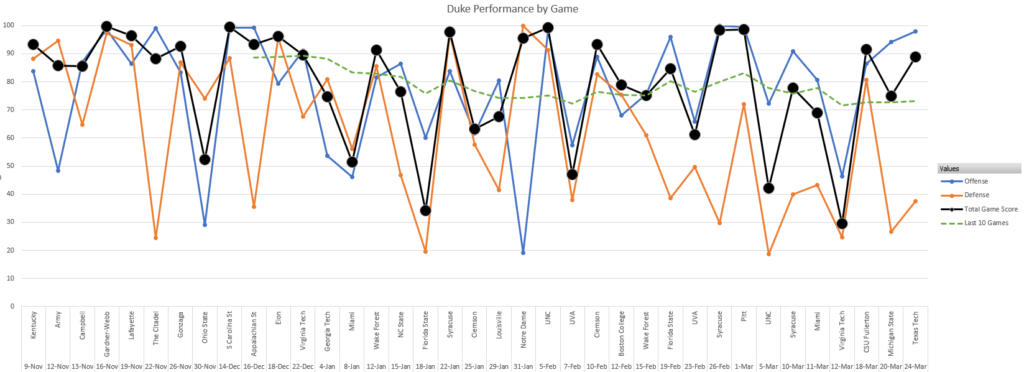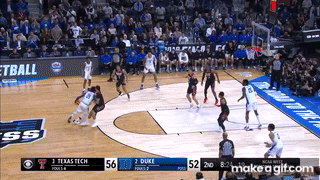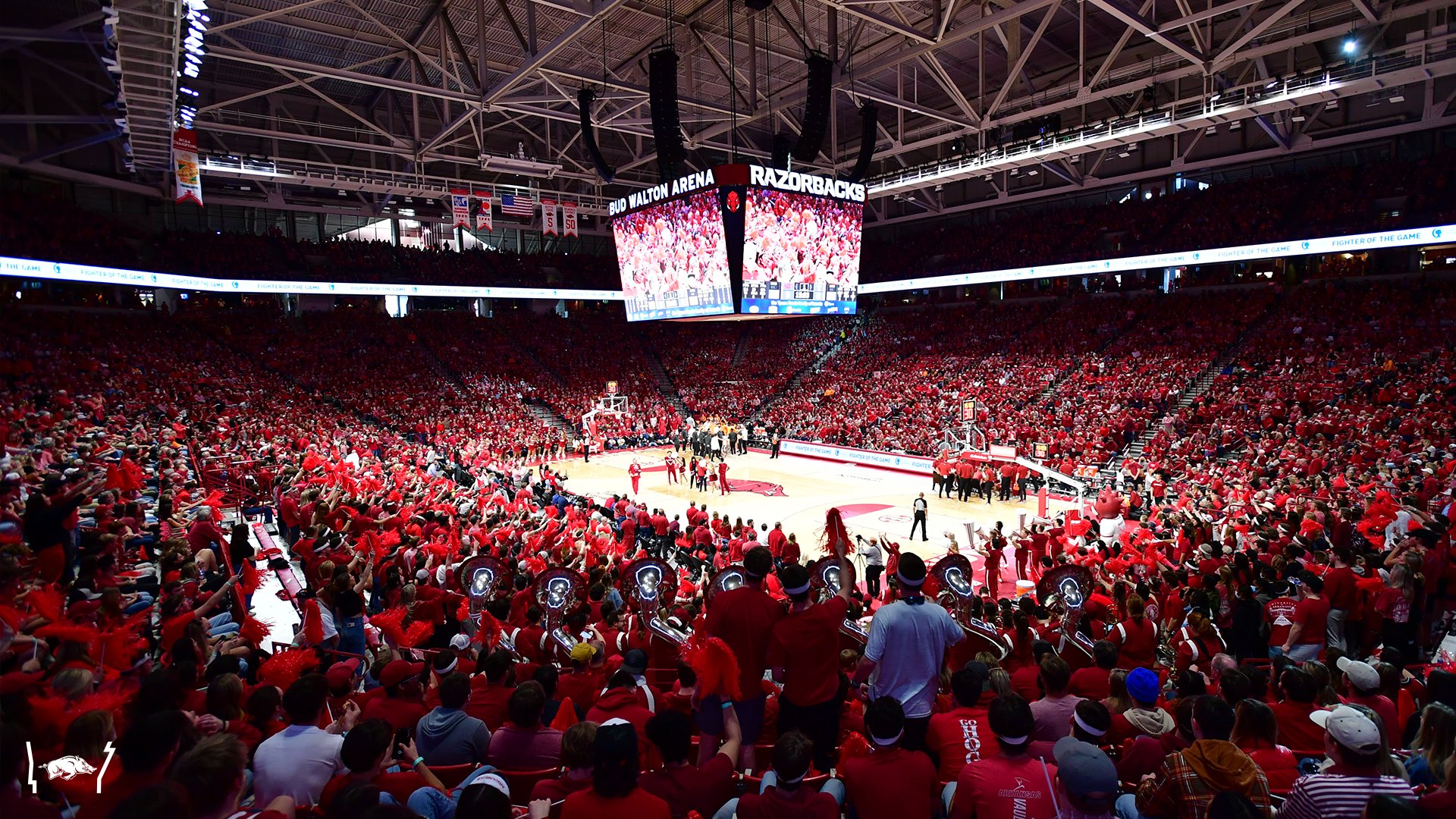It’s already been a season of memorable moments: the home wins over Auburn, Tennessee, and Kentucky in back-to-back-to-back weeks, another Sweet 16, the upset of Gonzaga. Now the stage is set for biggest one of all: a trip to the Final Four for the first time since 1995, and a shot to send Duke coach Mike Krzyzewski out with a loss to the Hogs in his final game.
Meet the Blue Devils
Confused? Check out the advanced stats glossary to learn more about the stats cited here.
Duke’s got a “team of destiny” thing going in Coach K’s farewell tour. The Blue Devils were a top-10 team all season but faded down the stretch, losing badly to North Carolina in their home finale and then falling to Virginia Tech in the ACC Tournament title game. But they’ve been workmanlike in the Dance, beating CSU Fullerton and Michigan State to advance to the Sweet 16, and then escaping a dangerous Texas Tech team in a 78-73 thriller. Texas Tech’s defense is ranked #1 in Adjusted Defensive Efficiency, but Duke did not miss a field goal in the final 8:55 of that game. They shot 71 percent in the second half.
The Blue Devils actually beat Gonzaga earlier this year, less you thought this was a significantly easier game. This is the Elite Eight, it never is “easier”.
Team Profile

It’s strength-on-strength and weakness-on-weakness when these teams get together. Duke has an elite offense (9th) to pair with Arkansas’ elite defense (19th), while both teams are lagging a bit on the other side of the ball.

You can see the late-season swoon and that it was largely driven by struggles on defense (orange line). We’ll get into it below, but Duke sometimes looks like a collection of offensive-minded players who are being forced to play defense, so they can appear undisciplined and unfocused. The danger of playing a team like that is that if the game tightens, their focus and intensity might pick up suddenly.
Our model pick is Duke 77, Arkansas 73, which matches Vegas, where Duke opened as 4-point favorites. That score is also dangerously close to the 76-72 score that will have some significance for Hog fans should the game end that way.
Personnel Profile
Okay, good, between Auburn and Gonzaga, I hated playing against a team whose two best players are a 7’0 center and a 6’10 forward. Thankfully we’re past…….
Oh no.

Yep, Duke’s two best players are 7’0 center Mark Williams and 6’10 forward Paolo Banchero. Apparently that’s the trendy way to construct a roster.
Williams isn’t like Walker Kessler or Chet Holmgren, though. He’s much thicker (240 pounds) and more of a traditional low-post grinder. He’s taken just one 3-pointer all year (and missed it), but he leads the team in offensive rebounds and blocked shots. Duke doesn’t run a ton of offense through him: he’s mostly just there to be a putback machine on offense and bridge troll on defense.
Banchero, on the other hand, is similar to Auburn’s Jabari Smith. He’s a three-level scorer who leads the team in scoring and rebounding and is second in assists. Duke runs everything through him. He’ll probably touch the ball on every halfcourt possession.
Duke’s guardplay is a wildcard. The Dukies have two dangerous off-ball guards: AJ Griffin and Wendell Moore. Both shoot north of 40% from beyond the arc. I imagine one of them will be Au’Diese Toney’s assignment. Duke has two point guards, and they often play together: Jeremy Roach and Trevor Keels. They really aren’t that good, but they are very traditional pass-first point guards who look to pass instead of scoring, especially Roach.
When Arkansas has the ball

If you’ve ever watched Duke over the years, you know how they play defense: man-to-man. Their signature tradition in slapping the floor when they fall back into their halfcourt defense as a way to signal their intensity. They’ve been doing it since Coach K arrived in the 1980s. They actually briefly switched to a zone late in the game against Texas Tech, something they’ve done here and there for the last few years.
Duke’s defenses have had the same statistical profile for years: they don’t force turnovers at all. Instead, they focus on smothering the perimeter and staying in front of their man. They don’t prevent shots at the rim, so their defense requires a rim protector (Williams) to work well.
The “smothering the perimeter” thing that is a feature of Coach K’s defenses won’t really bother the Hogs, who aren’t looking to get a lot of perimeter shots anyway. Duke’s defense funnels everything inside, and the Hogs will happily go inside and be physical around the rim.

Because they crash the offensive glass (more on that below), Duke allows opponents to get in transition too much. When they can contain the opponent in halfcourt, they are better off, ranking 46th in halfcourt efficiency defense.
Texas Tech — not an elite offensive team — had a good offense game against Duke due largely to transition. The Red Raiders only got in transition on 21% of possessions, but they had a staggering 71% floor percentage and a 150.0 efficiency on those possessions. In North Carolina’s 94-81 win at Cameron in the season finale, the Tar Heels ran on 24% of possessions and posted a 138.9 efficiency and 61% floor. Ditto for Virginia Tech in the ACC title game: just 14% transition rate (the Hokies don’t run at all), but 188.9 efficiency (!) and 89% floor (!!!).
Again, this comes back to Duke sometimes appearing undisciplined and unfocused on defense. Getting back can be an issue. If Duke doesn’t match Arkansas’ intensity in transition, the Hogs can score a ton of points.

Duke does not prevent you from shooting the ball. I mean that seriously: they are dead-last in Division I at allowing shots to go up (94.4 field goals attempted per 100 possessions). They don’t force turnovers (336th), are mediocre at defensive rebounding (207th), and they don’t foul much (6th in free throw rate), so possessions against them almost always end in a shot attempt (or a couple shot attempts).
In that way, Arkansas’ plan to attack Duke will be similar to the plan against Gonzaga: get shots up as often as possible, and you can win the game without shooting better. The Hogs put up an FTAR of 93.5 against the Zags — fourth-most of the year — and they could actually top that against Duke. In fact, they might have to in order to win.
Now when it comes to defending those shots, Duke is pretty good, ranking 29th in Adjusted Effective Field Goal %. Duke allows the 44th-lowest 3-point share (just 33% of shots against them are from deep). However, they allow too many shots at the rim (37%, 252nd). That bottom stat, Proximity, measures the average distance from the rim for each shot: each rim shot is 1, each midrange shot is 2, each 3-pointer is 3 (I took the idea for this stat from basketball stats guru Erik Haslem). You generally would like to force opponents away from your basket, but Duke doesn’t do that. Instead, they try to defend without fouling at the rim (46th in Rim % defense), a strategy that Arkansas will certainly test.
When Duke has the ball

In possession, the Blue Devils are deliberate. They rank just 198th in transition percentage and 124th in average possession length. They score on 54% of possessions — 3rd-best in the nation — and are therefore able to consistently attack defenses.

The Blue Devils are solid in transition, but they are very careful about when they run, ranking just 87th in scoring rate from transition buckets. So this is definitely more of a halfcourt team, scoring on half of its halfcourt possessions.
Duke has always run some form of motion offense under Coach K. There are some similarities to Gonzaga in that they will constantly occupy the post with their big man. You’ll see constant movement without the ball and you’ll see perimeter players maintaining spacing.
Banchero keys the offense. Despite his height, he’s an old-school NBA wing in terms of play style, which is why the algorithm that sets our position on the personnel profile table above calls him a “small forward”, which is a catch-all term for wings, small forwards, and taller combo guards. (It does the same thing for Jabari Smith, whose statistical profile is similar.)
Banchero plays on all three levels. He’s second on the team in assists:

When he’s shooting, you’ll see him take a lot of NBA wing shots, like this baseline midrange jumper:

And while he isn’t an elite 3-point shooter (32 percent), he’s dangerous enough to warrant attention:

I think Arkansas’ defensive plan will be similar to the Auburn game: Trey Wade will defend Banchero. He’s giving up about four inches, but his main task will be to stay in front of Banchero on 3-pointers and midrange jumpers. If Banchero drives to the rim, Williams will be inside to help. That leaves some Williams on Williams defense, with Jaylin covering Mark. This is ideal because Mark Williams is neither a perimeter player nor a ballhandler.

Duke is the first team Arkansas has seen in this tournament with an excellent offensive EPR. That means that Duke generates a lot of shot chances — 99.7 per 100 possessions — due to both a low turnover rate and a high offensive rebounding rate. The offensive rebounds are a potential concern due to Duke’s height advantage inside: the Blue Devils, like Auburn, will actually use their height and athleticism and can punish the Hogs’ scrappy but smaller roster.
When they shoot, they make at a high rate. Duke is 3rd in True Shooting and 5th in Effective Field Goal %. Their shot selection is excellent: they are 26th in getting shots at the rim and 5th in making them. They don’t take a ton of 3-pointers, but they do hit at a good clip from everywhere they shoot. Arkansas is very good at defending jumpers of all kinds and at preventing shots at the rim… but if opponents can get shots at the rim, they can make them. That’s the difficulty of this matchup for the Razorback defense. Of course, Gonzaga was 28th at getting to the rim and 6th at Rim FG%, and the Hogs held them well below their season averages on both counts.
Keys to the Game
#1 Win at the rim.
When you play Duke, you’re asking for an old-school game at the rim. Duke’s offense attacks the rim and its defense funnels you into the rim. This game will be won or lost within about six feet of the basket. Arkansas needs to use its physicality on offense to attack Duke’s rim protector and either draw fouls or scared defense. Defensively, the Hogs will have to deny layups, dunks, and putbacks. This is absolutely a game where Jaylin Williams has to show out on both ends.
#2 Get in transition.
Duke’s players love to play offense. They don’t always look like they love playing defense, especially when the opponent wants to be aggressive. The Hogs need to be in transition as often as possible, forcing the issue and draining Duke mentally. The Blue Devils prefer to be in their halfcourt defense, where they are solid.
#3 Prepare for a shootout.
This might not actually be a shootout: the way Arkansas’ defense is playing right now, I think they can keep the lid on the opposing offense just fine. But you still have to play smart: Duke is so methodical on offense that you can’t waste possessions against them. The Blue Devils don’t force turnovers at all, so any bad pass or offensive foul or violation is giving Duke a gift they don’t need. The same goes for shot selection: Duke isn’t going to force the Hogs to jack up a ton of 3-pointers, so any wild 3-point try that misses the rim is a gift.
The Hogs and Blue Devils tip off at 7:49 pm Saturday on TBS.
The latest from Fayette Villains, straight to your inbox
Enter your email to subscribe and receive new post alerts and other updates. You can unsubscribe at any time.
